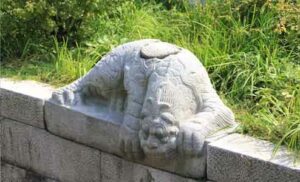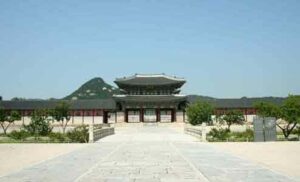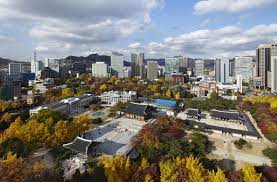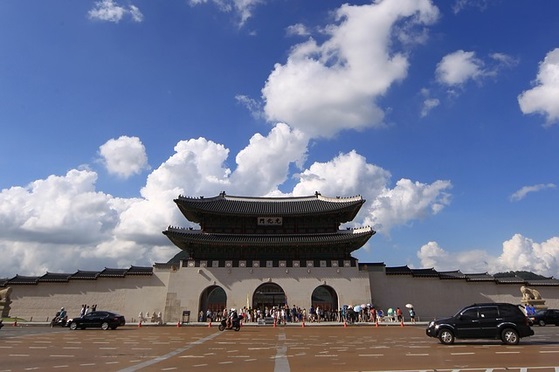From Gwanghwamun main gate to Geunjeongjeon main hall of Gyeongbokgung Palace, there are attractive points that you will meet and may wonder what they are and how they were used: Yeongjaegyo Bridge, Three-tiered Road (Samdo in Korean), Rank stones (Pumgyeseok in Korean), Bakseok, and Iron Rings (Chailgori in Korean).
Before Geunjeongjeon main hall: Yeongjaegyo Bridge (영제교)
Yeongjaegyo is the bridge that you met before coming into the main area of the Gyeongbokgung Palace. It used to have a stream underneath the bridge so the officials were able to purify themselves before entering the king’s holy area. However, it was demolished during the Japanese colonial period as the Japanese general government building of Korea was placed here. Here, there is a funny statue called Cheonrok which looks like a deer. We believed that this imaginary animal will appear when the King rules his country well and wisely. Although the palace is solemn and follows the specifications of the main palace, they look very friendly and funny. Not only this statue, but you will also see many friendly statues in Gyeongbok Palace instead of being scary!

In front of Geunjeongjeon main hall: Three-tiered Road / Three Paths (삼도)
There is a three-tiered Road called Samdo in Korean. As you can see, the middle of the road is slightly elevated than another two. The king used this road while officials used the side roads. You can be a king by walking through the middle road!

In front of Geunjeongjeon main hall: Rank stones (품계석)
These are the rank stones where the officials were standing following their ranking. Each of them represents a different hierarchical status within the 18-level government system. Each government official would stand in front of the rank stone according to their hierarchically appropriate position when attending ceremonies and morning court sessions.
However, you can see, there are only 12 stones although there was 18 level government system. The system had nine levels and each level had two different classes: Jeong (정) and Jong (종). There brings us to a total of 18 levels. However, actually, only the three highest levels had both 정 and 종, and the levels from four down to nine had only the Jeong class
In front of Geunjeongjeon main hall: Bakseok (박석)
There are stones in the yard of Geunjeongjeon main hall, which are called Bakseok, which means thin stone. It’s not because there were no stone processing skills during the Joseon dynasty. It’s because a king and officials in attendance would have had to squint because of the sunlight reflected off the thin stones if their surfaces were polished as smooth as marble.
Bakseok was intentionally finished that way not only to protect their eyes but also to prevent slipperiness on rainy days. You should understand that Joeson officials’ shoes had wooden soles, which easily get slippery when wet.
In front of Genjeongjeon main hall: Iron Rings (차일고리)
These rings were for fixing sunshades used during special events or banquets in order to prevent them from fluttering in the wind.



